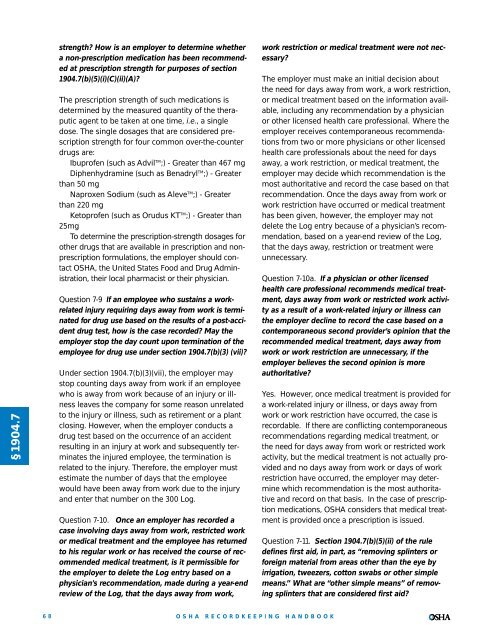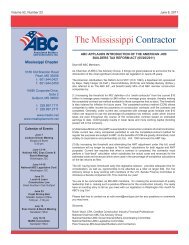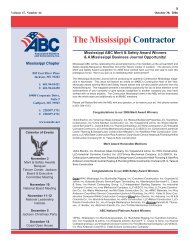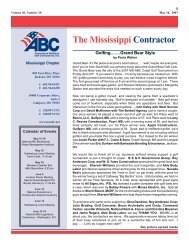§1904.7strength? How is an employer to determine whethera non-prescription medication has been recommendedat prescription strength for purposes of section1904.7(b)(5)(i)(C)(ii)(A)?The prescription strength of such medications isdetermined by the measured quantity of the theraputicagent to be taken at one time, i.e., a singledose. The single dosages that are considered prescriptionstrength for four common over-the-counterdrugs are:Ibuprofen (such as Advil TM ;) - Greater than 467 mgDiphenhydramine (such as Benadryl TM ;) - Greaterthan 50 mgNaproxen Sodium (such as Aleve TM ;) - Greaterthan 220 mgKetoprofen (such as Orudus KT TM ;) - Greater than25mgTo determine the prescription-strength dosages forother drugs that are available in prescription and nonprescriptionformulations, the employer should contact<strong>OSHA</strong>, the United States Food and Drug Administration,their local pharmacist or their physician.Question 7-9 If an employee who sustains a workrelatedinjury requiring days away from work is terminatedfor drug use based on the results of a post-accidentdrug test, how is the case recorded? May theemployer stop the day count upon termination of theemployee for drug use under section 1904.7(b)(3) (vii)?Under section 1904.7(b)(3)(vii), the employer maystop counting days away from work if an employeewho is away from work because of an injury or illnessleaves the company for some reason unrelatedto the injury or illness, such as retirement or a plantclosing. However, when the employer conducts adrug test based on the occurrence of an accidentresulting in an injury at work and subsequently terminatesthe injured employee, the termination isrelated to the injury. Therefore, the employer mustestimate the number of days that the employeewould have been away from work due to the injuryand enter that number on the 300 Log.Question 7-10. Once an employer has recorded acase involving days away from work, restricted workor medical treatment and the employee has returnedto his regular work or has received the course of recommendedmedical treatment, is it permissible forthe employer to delete the Log entry based on aphysician’s recommendation, made during a year-endreview of the Log, that the days away from work,work restriction or medical treatment were not necessary?The employer must make an initial decision aboutthe need for days away from work, a work restriction,or medical treatment based on the information available,including any recommendation by a physicianor other licensed health care professional. Where theemployer receives contemporaneous recommendationsfrom two or more physicians or other licensedhealth care professionals about the need for daysaway, a work restriction, or medical treatment, theemployer may decide which recommendation is themost authoritative and record the case based on thatrecommendation. Once the days away from work orwork restriction have occurred or medical treatmenthas been given, however, the employer may notdelete the Log entry because of a physician’s recommendation,based on a year-end review of the Log,that the days away, restriction or treatment wereunnecessary.Question 7-10a. If a physician or other licensedhealth care professional recommends medical treatment,days away from work or restricted work activityas a result of a work-related injury or illness canthe employer decline to record the case based on acontemporaneous second provider’s opinion that therecommended medical treatment, days away fromwork or work restriction are unnecessary, if theemployer believes the second opinion is moreauthoritative?Yes. However, once medical treatment is provided fora work-related injury or illness, or days away fromwork or work restriction have occurred, the case isrecordable. If there are conflicting contemporaneousrecommendations regarding medical treatment, orthe need for days away from work or restricted workactivity, but the medical treatment is not actually providedand no days away from work or days of workrestriction have occurred, the employer may determinewhich recommendation is the most authoritativeand record on that basis. In the case of prescriptionmedications, <strong>OSHA</strong> considers that medical treatmentis provided once a prescription is issued.Question 7-11. Section 1904.7(b)(5)(ii) of the ruledefines first aid, in part, as “removing splinters orforeign material from areas other than the eye byirrigation, tweezers, cotton swabs or other simplemeans.” What are “other simple means” of removingsplinters that are considered first aid?68<strong>OSHA</strong> RECORDKEEPINGHANDBOOK
“Other simple means” of removing splinters, for purposesof the first-aid definition, means methods thatare reasonably comparable to the listed methods.Using needles, pins or small tools to extract splinterswould generally be included.Question 7-12. How long must a modification to ajob last before it can be considered a permanentmodification under section 1904.7(b)(4)(xi)?Section 1904.7(b)(4)(xi) of the rule allows an employerto stop counting days of restricted work or transferto another job if the restriction or transfer is madepermanent. A permanent restriction or transfer is o<strong>net</strong>hat is expected to last for the remainder of theemployee’s career. Where the restriction or transfer isdetermined to be permanent at the time it is ordered,the employer must count at least one day of therestriction or transfer on the Log. If the employeewhose work is restricted or who is transferred toanother job is expected to return to his or her formerjob duties at a later date, the restriction or transfer isconsidered temporary rather than permanent.Question 7-13. If an employee loses his arm in awork-related accident and can never return to hisjob, how is the case recorded? Is the day countcapped at 180 days?If an employee never returns to work following awork-related injury, the employer must check the“days away from work” column, and enter an estimateof the number of days the employee wouldhave required to recuperate from the injury, up to180 days.Question 7-14. If an employee who routinely worksten hours a day is restricted from working more thaneight hours following a work-related injury, is thecase recordable?Generally, the employer must record any case inwhich an employee’s work is restricted because of awork-related injury. A work restriction, as defined insection 1904.7(b)(4)(i)(A), occurs when the employerkeeps the employee from performing one or moreroutine functions of the job, or from working the fullworkday the employee would otherwise have beenscheduled to work. The case in question is recordableif the employee would have worked 10 hours had heor she not been injured.Question 7-15. If an employee is exposed to chlorineor some other substance at work and oxygen isadministered as a precautionary measure, is the caserecordable?If oxygen is administered as a purely precautionarymeasure to an employee who does not exhibit anysymptoms of an injury or illness, the case is notrecordable. If the employee exposed to a substanceexhibits symptoms of an injury or illness, the administrationof oxygen makes the case recordable.Question 7-16. Is the employer subject to a citationfor violating section 1904.7(b)(4)(viii) if an employeefails to follow a recommended work restriction?Section 1904.7(b)(4)(viii) deals with the recordabilityof cases in which a physician or other health careprofessional has recommended a work restriction.The section also states that the employer “shouldensure that the employee complies with the [recommended]restriction.” This language is purely advisoryand does not impose an enforceable duty uponemployers to ensure that employees comply with therecommended restriction. [Note: In the absence ofconflicting opinions from two or more health careprofessionals, the employer ordinarily must recordthe case if a health care professional recommends awork restriction involving the employee’s routine jobfunctions.]Question 7-17. Are work-related cases involvingchipped or broken teeth recordable?Yes, under section 1904.7(b)(7), these cases are considereda significant injury or illness when diagnosedby a physician or other health care professional. Asdiscussed in the preamble of the final rule, workrelatedfractures of bones or teeth are recognized asconstituting significant diagnoses and, if the conditionis work-related, are appropriately recorded at thetime of initial diagnosis even if the case does notinvolve any of the other general recording criteria.Question 7-18. How would the employer record thechange on the <strong>OSHA</strong> 300 Log for an injury or illnessafter the injured worker reached the cap of 180 daysfor restricted work and then was assigned to “daysaway from work”?The employer must check the box that reflects themost severe outcome associated with a given injury§1904.7<strong>OSHA</strong> RECORDKEEPINGHANDBOOK69
- Page 1 and 2:
www.osha.govOSHARecordkeepingHandbo
- Page 3 and 4:
OSHARecordkeeping HandbookThe Regul
- Page 5 and 6:
ContentsRecordkeeping HandbookRoadm
- Page 7 and 8:
Section 1904.40Providing records to
- Page 9 and 10:
Section 1904.0Purpose(66 FR 6122, J
- Page 11 and 12:
Section 1904.1Partial exemption for
- Page 13 and 14:
Section 1904.2Partial exemption for
- Page 15 and 16:
employees, to OSHA within 8 hours (
- Page 17 and 18:
Partial Exemptions for Employers Un
- Page 19 and 20:
Section 1904.4Recording criteria(66
- Page 21 and 22:
Section 1904.5Determination of work
- Page 23 and 24:
(b)(7) How do I decide if a case is
- Page 25 and 26: well, including providing informati
- Page 27 and 28: This exception, which responds to i
- Page 29 and 30: or she is in the work environment a
- Page 31 and 32: have occurred but for the occupatio
- Page 33 and 34: considered work-related. If an empl
- Page 35 and 36: Question 5-12. Is work-related stre
- Page 37 and 38: • The doctor described the illnes
- Page 39 and 40: Scenario 7:• A site hired numerou
- Page 41 and 42: Letter of interpretation related to
- Page 43 and 44: These principles should be applied
- Page 45 and 46: The problem with the response is tw
- Page 47 and 48: Section 1904.6Determination of new
- Page 49 and 50: the Guidelines stated that “the a
- Page 51 and 52: estricted work. If the case is a pr
- Page 53 and 54: • The doctor also prescribed the
- Page 55 and 56: • The employees were under the di
- Page 57 and 58: Section 1904.7General recording cri
- Page 59 and 60: (iii) Do I have to record restricte
- Page 61 and 62: of the length of time the employee
- Page 63 and 64: then result in days away from work
- Page 65 and 66: A partial day of work is recorded a
- Page 67 and 68: In all other respects, the final ru
- Page 69 and 70: ments. The Agency believes that the
- Page 71 and 72: e recorded because it will require
- Page 73 and 74: However, episodes of fainting from
- Page 75: care professional, he or she may al
- Page 79 and 80: For purposes of OSHA recordkeeping
- Page 81 and 82: • When answering the doctor’s q
- Page 83 and 84: Response: In the recordkeeping regu
- Page 85 and 86: Letter of interpretation related to
- Page 87 and 88: Section 1904.8Recording criteria fo
- Page 89 and 90: caused by contaminated needles and
- Page 91 and 92: Section 1904.9Recording criteria fo
- Page 93 and 94: Section 1904.10Recording criteria f
- Page 95 and 96: hearing loss case that is not relat
- Page 97 and 98: average of 10 decibels or more at 2
- Page 99 and 100: argued that because the function of
- Page 101 and 102: occurs, and where hearing loss can
- Page 103 and 104: cases in their workplace via analys
- Page 105 and 106: March 4, 2004Mr. Carl O. Sall, CIHD
- Page 107 and 108: When the professional evaluating th
- Page 109 and 110: (2) May I line-out or erase a recor
- Page 111 and 112: Section 1904.12Recording criteria f
- Page 113 and 114: These new statistics would add only
- Page 115 and 116: Sections 1904.13 - 1904.28 Reserved
- Page 117 and 118: two lines of the OSHA 300 Log to de
- Page 119 and 120: which replace the OSHA 200 and 101
- Page 121 and 122: different types of occupational ill
- Page 123 and 124: OSHA 301 form. These data are usefu
- Page 125 and 126: LETTERS OF INTERPRETATION: Section
- Page 127 and 128:
Question 2: Under 29 CFR Section 19
- Page 129 and 130:
and has adopted language in the fin
- Page 131 and 132:
Section 1904.31Covered employees(66
- Page 133 and 134:
label assigned to a worker is immat
- Page 135 and 136:
These workers should be evaluated j
- Page 137 and 138:
Response: A case is work-related if
- Page 139 and 140:
Response: Section 1904.31 states th
- Page 141 and 142:
Thank you for your interest in occu
- Page 143 and 144:
year covered by the summary. The su
- Page 145 and 146:
2. Number of employees and hours wo
- Page 147 and 148:
LETTERS OF INTERPRETATION: Section
- Page 149 and 150:
Section 1904.33Retention and updati
- Page 151 and 152:
June 23, 2003Mr. Edwin G. Foulke, J
- Page 153 and 154:
Section 1904.34Change in business o
- Page 155 and 156:
PREAMBLE DISCUSSION: Section 1904.3
- Page 157 and 158:
Incident Report (Forms 300 and 301,
- Page 159 and 160:
workers’ compensation claim. See
- Page 161 and 162:
LETTERS OF INTERPRETATION: Section
- Page 163 and 164:
Letter of interpretation related to
- Page 165 and 166:
Question 3: Using the facts in Ques
- Page 167 and 168:
Section 1904.37State recordkeeping
- Page 169 and 170:
tion, require employers to report f
- Page 171 and 172:
(5) If I receive a variance, may th
- Page 173 and 174:
Section 1904.39Reporting fatalities
- Page 175 and 176:
gation. Therefore, the final rule d
- Page 177 and 178:
Section 1904.40Providing records to
- Page 179 and 180:
ness. The government inspector may
- Page 181 and 182:
Response: The controlling employer
- Page 183 and 184:
FREQUENTLY ASKED QUESTIONS: Section
- Page 185 and 186:
OSHA and the BLS have worked togeth
- Page 187 and 188:
provide copies of the retained reco
- Page 189 and 190:
FREQUENTLY ASKED QUESTIONS: Section
- Page 191 and 192:
Section 1904.46Definitions(66 FR 61
- Page 193 and 194:
of business information. For exampl
- Page 195 and 196:
inconvenience associated with keepi
- Page 197 and 198:
skin disease, respiratory disorder,
- Page 199 and 200:
Question 2: Under 29 CFR Section 19
- Page 201:
www.osha.gov







